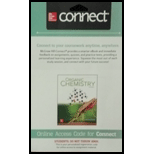
(a)
Interpretation: The triene that has largest heat of hydrogenation is to be predicted.
Concept introduction: Conjugated diene consists of two double bonds that are separated by a single bond, whereas isolated diene also consists of two double bond but they are separated by two or more carbon atoms.
The stability of conjugated diene is more than isolated diene. Due to which the heat of hydrogenation is smaller for conjugated diene, whereas heat of hydrogenation for isolated diene is larger.
(b)
Interpretation: The triene that has smallest heat of hydrogenation is to be predicted.
Concept introduction: Conjugated diene consists of two double bonds that are separated by a single bond, whereas isolated diene also consists of two double bond but they are separated by two or more carbon atoms.
The stability of conjugated diene is more than isolated diene. Due to which the heat of hydrogenation is smaller for conjugated diene, whereas heat of hydrogenation for isolated diene is larger.
(c)
Interpretation: The triene that absorbs the longest
Concept introduction: Conjugated diene consists of two double bonds that are separated by a single bond, whereas isolated diene also consists of two double bond but they are separated by two or more carbon atoms.
The energy difference between the ground and excited state decreases when number of conjugated bonds increases. Due to this absorption shifts to the longer wavelengths.
(d)
Interpretation: The triene that is most reactive in the Diels-Alder reaction is to be predicted.
Concept introduction: Conjugated diene consists of two double bonds that are separated by a single bond, whereas isolated diene also consists of two double bond but they are separated by two or more carbon atoms.
The stability of conjugated diene is more than isolated diene.
Trending nowThis is a popular solution!

Chapter 16 Solutions
Connect Access Card Two Year for Organic Chemistry
- The Diels–Alder reaction, a powerful reaction discussed in Chapter 14, occurs when a 1,3-diene such as A reacts with an alkene such as B to form the six-membered ring in C. a.Draw curved arrows to show how A and B react to form C. b.What bonds are broken and formed in this reaction? c.Would you expect this reaction to be endothermic or exothermic? d.Does entropy favor the reactants or products? e. Is the Diels–Alder reaction a substitution, elimination, or addition?arrow_forwardWhich alkene in each pair has the larger heat of hydrogenation? See in attachment ?arrow_forwardThe bicyclic alkene P can be prepared by thermal electrocyclic ring closure from cyclodecadiene Q or by photochemical electrocyclic ring closure from cyclodecadiene R. Draw the structures of Q and R, and indicate the stereochemistry of the process by which each reaction occurs.arrow_forward
- Question: What is the principle behind the Markovnikov's rule in the addition of HX (where X is a halogen) to an alkene, and what is the exception to this rule?arrow_forwardDraw the products of each Diels–Alder reaction, and indicate the stereochemistry.arrow_forwardWhich alkene in each pair has the larger heat of hydrogenation?arrow_forward
- Compounds A and B are isomers having molecular formula C5H12. Heating A with Cl2 gives a single product of monohalogenation, whereas heating B under the same conditions forms three constitutional isomers. What are thestructures of A and B?arrow_forwardExplain the concept of Hydrogenation Data and Degrees of Unsaturation ?arrow_forwardSelect the conjugated diene which cannot undergo the Diels-Alder reaction.arrow_forward
- Which heterocycles are aromatic?arrow_forwardA chiral alkyne A with molecular formula C6H10 is reduced with H2 and Lindlar catalyst to B having the R conguration at its stereogenic center. What are the structures of A and B?arrow_forwardWhich of the statement is INCORRECT? a. The increase in stability of 2,4-hexadiene over 1,3-hexadiene is due to the increased double bond substitution of the former. b. The stabilization of dienes by conjugation is less pronounced than the aromatic stabilization of benzene. c. Resonance description in alkenes usually involves charge separation. d. Higher energy pi-orbitals often have decreasing number of nodes.arrow_forward
